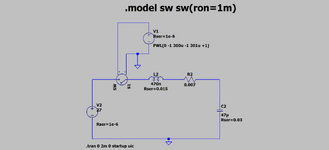cupoftea
Advanced Member level 6

Hi,
We wish to solve a circuit which is a step response of a series RLC circuit.
We wish to find the peak of the capacitor voltage following the step.
Its underdamped. Initial conditions are all zero apart from the supply = 27V
So We are solving the Fig 1 on page 1 of this....
We wish to find vc(t). As such we will find the peak of the vc.
So we have the underdamped case since VS=27, L=470nH, C=47uF, R = 0.034
So we need to find A1 and A2 in equation 1.15 of page 2.
At t=0, all voltages and currents are zero, so A1 + A2 = -27 ___[A]
Then we have to do dvc(t)/dt at t=0.
However, this ends up with 0 = -a(A1+A2) -jwd(A1-A2)
where wd = SQRT(wo^2-a^2)
..but that could only be true if A1 + A2 = 0, and we already found out as above in [A], that A1+A2 = -27
Do you know where we have veered off?
We wish to solve a circuit which is a step response of a series RLC circuit.
We wish to find the peak of the capacitor voltage following the step.
Its underdamped. Initial conditions are all zero apart from the supply = 27V
So We are solving the Fig 1 on page 1 of this....
We wish to find vc(t). As such we will find the peak of the vc.
So we have the underdamped case since VS=27, L=470nH, C=47uF, R = 0.034
So we need to find A1 and A2 in equation 1.15 of page 2.
At t=0, all voltages and currents are zero, so A1 + A2 = -27 ___[A]
Then we have to do dvc(t)/dt at t=0.
However, this ends up with 0 = -a(A1+A2) -jwd(A1-A2)
where wd = SQRT(wo^2-a^2)
..but that could only be true if A1 + A2 = 0, and we already found out as above in [A], that A1+A2 = -27
Do you know where we have veered off?



